|
FAQs on Identification of
Stinging-Celled Animals
28
Related Articles: Cnidarians,
Water Flow, How Much
is Enough,
Related FAQs: Cnidarian IDs 1, Cnidarian IDs 2, Cnidarian IDs 3, Cnidarians ID 4, Cnidarians ID 5, Cnidarians ID 6, Cnidarian ID 7, Cnidarian ID 8, Cnidarian ID 9, Cnidarian ID 10, Cnidarian ID 11, Cnidarian ID 12, Cnidarian ID 13, Cnidarian ID
14, Cnidarian ID
15, Cnidarian ID
16, Cnidarian ID 17, Cnidarian ID 18, Cnidarian ID 19, Cnidarian ID 20, Cnidarian ID 21, Cnidarian ID 22, Cnidarian ID 23, Cnidarian ID 24, Cnidarian ID 25, Cnidarian ID 26, Cnidarian ID 27,
Cnidarian
ID 29,
Cnidarian ID 30,
Cnidarian ID 31,
& Anemone ID 1, Aiptasia
ID 1, Stony Coral ID
1, Mushroom Identification,
Soft Coral ID, Alcyoniid ID, Xeniid ID, Cnidarians 1, Cnidarians 2, Cnidarian Behavior, Cnidarian Compatibility, Cnidarian Selection, Cnidarian Systems, Cnidarian Feeding, Cnidarian Disease, Cnidarian Reproduction,
Acclimating
Symbiotic Reef Invertebrates to Captive Lighting,
|
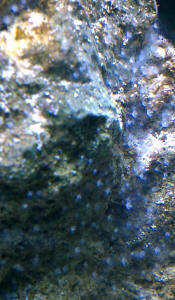
|
|
Identification required 9/1/11
Hi,
<Hello>
I have used your site extensively, but could not find the species
I have received as present. Thanks for a great site.
I would like to identify the coral in the image attached.
Kindest Regards
RENIER HUGO
<This appears to be a Zoanthid, likely of the genus Palythoa.
DO make sure and wash your hands after they've been in
contact w/ this animal/colony, or even just the system water. DO
read here re:
http://wetwebmedia.com/ZoCompF2.htm
Bob Fenner>
|
|
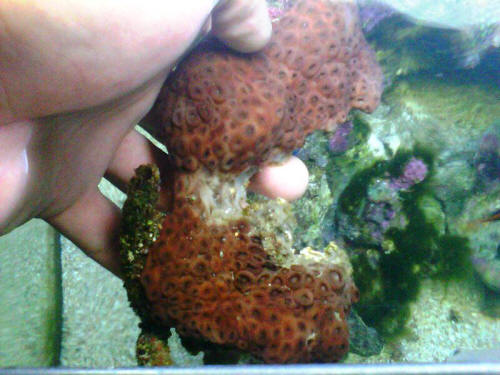
Re: Identification required 9/2/11
Hi Bob,
<RH>
Thanks very much for the reply. Would you recommend I remove this
coral altogether? After reading the posts on the website, I
gathered that they can turn into a pest due to their aggressive
nature/poison.
<A possibility>
I keep lots of other zoa's, buttons, cloves etc, fish,
bristle stars etc and as far as I am aware they are pretty
safe?
<Maybe... the fact that you have the other Zoanthids... you
may be fine>
My questions really: They are not the prettiest, should I
"bin" them?
<I'd at the very least slowly acclimate each to each
through mixing water back and forth in separate systems for a few
weeks>
Regards
Renier
<And you, BobF>
|
|
Aiptasia (hopefully not) and Other Items Needing
Identification/Coral ID/Reef Lighting 8/24/11
Hey guys,
<Matt>
I am new to the SW Reef aquarium and am in the process of cycling
my new tank. I decided to go the route of live rock, and of
course similar to a ton of posts on your site I have questions in
indentifying things. My main concern is obviously Aiptasia, and I
want to make sure I get started on the right path. The 1st and
2nd pics are what I assume to be button polyps.
<Yes, a Zoanthus species. Learn more here. http://www.wetwebmedia.com/zoanthid.htm>
I have an abundance of these.
<And they can quickly take over a tank if not
controlled.>
The 3rd pic is some sort of mushroom, they seem to be spreading.
The 4th pic is another mushroom like growth, but solid purple.
The 5th pic seems to be another mushroom growth, but brown. I
apologize for all the pics, but thought it would be easier to get
it out in one shot.
<These are all Corallimorphs, Mushroom Corals. More info can
be found here.
http://www.wetwebmedia.com/corallim.htm>
Can you tell me what the things in the pictures are? I really
appreciate your help and have used your site for virtually
everything to this point.
So you know, I think because of the research I have done on WWM
that I have cycled my tank in less than 2 weeks. Don't worry,
I'm not rushing anything though.. I will give it another
month or so. I have a 72 Gallon bow, sump,
protein skimmer, 3 sub pumps, and 60 pounds of live rock so far
along with 20 pounds of live sand. I am also using the
new Marineland LED Reef lighting. What are your thoughts about
these?
<They will support the above corals but I'm quite sure it
wouldn't be enough light for SPS/LPS corals.>
I have heard mixed reviews but don't have anything to compare
it to at this point since I have no coral, etc. to see if it
provides enough lighting.
Thanks again, and I appreciate your help.
<You're welcome. James (Salty Dog)>
Matt Mead
|
|
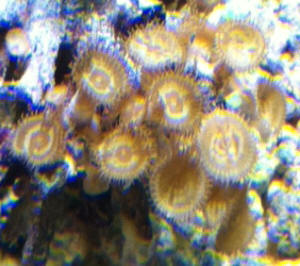 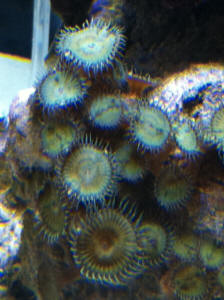
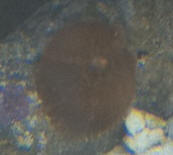 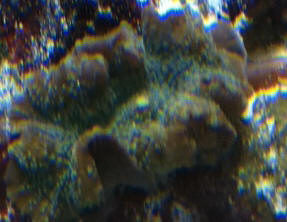 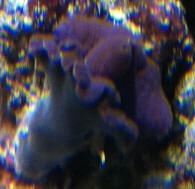
Re Aiptasia (hopefully not) and Other Items Needing
Identification/Coral ID/Reef Lighting 8/24/11-
8/25/11
Thanks for the quick response, it is appreciated!
<You're welcome.>
Regarding the LED lighting, if I added
an additional light would that help so in the future I
could house SPS/LPS corals? Or is the light in
your opinion just not good enough? A little misleading I think
since it states that it is "reef capable"....
<Yes, depending largely on what you want to keep. The Reef
Capable fixture uses one watt LEDs where
the more intense units use three watt LEDs. The PAR level at 12
inches depth measures 130 (referenced material, not measurements
I have taken), and falls off sharply to 61 at three inches off
center axis.
Not nearly enough intensity for most SPS corals and many LPS
corals at that depth. Most stony corals need about 250 PAR to
thrive and a photosynthetic usable radiation range (PUR) of about
440-700nm.
Your fixture may be enough for hard corals that thrive in
moderate light, but you would have to place them very near the
surface of the water. So in essence, it is reef capable. Two of
these fixtures would improve dispersion of your lighting but PAR
values at depth won't improve much if any. The price of the
unit should reflect it's capabilities.>
Thanks again, you guys are really a big help.
<You're welcome. James (Salty Dog)>
Matt
|
|
Mystery coral ID? 8/8/11
Good afternoon!
<Susan>
You have been my best resource for the last nine months. Just
before Christmas last year I received a new 60-gallon system
which - thanks in no small part to you - is thriving. It's a
dedicated seahorse/soft-coral system, which cycled for 3 months
with inverts (coco worms, snails, cleaner shrimp) before I added
the first corals or fish, and then I added corals very slowly
<Good>
and all from a single source (a local coral breeder/dealer),
compatibility-matched using your site and seahorse.org to ensure
incompatibility and health.
<Very good>
Dips, quarantines, and other solid measures are in place. A pair
of seahorses came in on June 10 (six months almost to the day
after the tank started running). Other fish tankmates are one
banded pipefish, one scooter blenny (pictured with coral) one
very fat green-spotted dragonet (the dragonets eat frozen mysis,
though I add tigger pods weekly also - this one has more than
doubled in size in the time I've had him - thanks in no small
part to reading on your site about his needs), one yellow
watchman goby and two blue neon gobies.
Invert population is one tuxedo urchin, one Staghorn hermit, six
coco worms, two feather duster worms, two skunk cleaners, three
peppermint shrimp (true peppermints), five very small mexican
red-legged hermits and a "janitorial squad" of trochus,
Nassarius, and Cerith snails.
The inn is full, and that's all I'm intending to add.
Everything is healthy, eating and growing.
<Ah, good>
I can't tell you how lucky I was to find you guys in advance.
I've learned from so many others' mistakes and...yes, I
read before I bring things home.
Tanks, like pregnancies, are better planned!
<Agreed>
But like everyone else, I succumbed to the "this looks
awesome, I think I will take it" syndrome with a coral. (I
can hear you shuddering from here.)
The coral breeder/LFS owner said he's seen thousands of
corals in his years in the business, but couldn't identify
this. He had put it in his own system to test it and see if it
stings (it didn't appear to) or was aggressive (it didn't
appear to be) and he thought I might like it. He also knows my
system is invertebrate-friendly and doesn't house many things
that could harm this.
So yeah, I brought it home. Photo is attached. It's been in
the tank 2 months with no issues. It's growing well
(isolated, as you can see, on its own piece of live rock in the
sand bed where it can't get into too much trouble. The photo
is a little blurred (sorry) but I included the scooter blenny for
size comparison. The photo is true-color. The coral's mouths
are open pretty much all the time except when it feeds. It seems
to filter feed from the water (I feed a combination of live
phyto/oyster feast/rotifers for the corals) and also loves mysis
(I feed frozen Hikari mysis/SF Bay Brand Omega enriched frozen
brine to the mandarin/scooter blenny and seahorses).
My question is..what the heck is it?
<A Zoanthid>
I've done hours of research but can't find a good photo
match to it anywhere, so I thought I'd send it along and see
if you guys know what it is I'm dealing with - partly because
if it's going to grow up into a fish-eater, I'd like to
know while I still have time to re-home it. The LFS owner/coral
breeder said he'd gladly take it back any time I don't
want it any more, so it has a good home either way.
Thanks in advance for your help and for the amazing resource you
provide.
I guarantee my tank would not be the success story it is without
WetWebMedia.
Susan Spann
<Please read here: http://wetwebmedia.com/zoanthid.htm
and the linked FAQs file above re this group's
Compatibility... There are some aspects of their biology you
should be aware of. Bob Fenner>
|
|
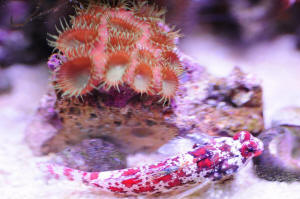
|
|
Re: Mystery coral ID?
8/9/11
Thank you very much Bob (and Company!),
<Welcome!>
I was delighted to see that this is apparently a (weird)
Zoanthid. My tank is very Zoanthid-friendly, and
though I won't move this one near any of the more
standard-looking varieties I think it will continue to get along
very well here. Thank you again for your help!
PS - I promise never to do the "ooh neat!" thing again.
It's too much stress!
<Heeeee! A common human trait... I often think that our
attentiveness to "new, shiny things" is likely a
positive trait, accounts for our apparent progress... Cheers,
BobF>
Re: Mystery coral ID? 8/9/11
One last email to thank you guys a final time. After reading
everything I could find on your Zoanthid pages (again...I have
some other Zoanthid/Palythoa species in the same tank) I've
finally identified the little guy! Palythoa
caesia -
<Ah yes>
I found images on the 'web that match mine exactly. Thank you
so much! (Incidentally, this also explains why it likes being
target fed frozen mysis along with the standard
phyto/oysterfeast/rotifer combination I feed the tank).
Thanks a ton! I don't think I ever would have found it
without you!
Susan Spann
<Cheers again. B>
|
|
Lighting question along with "what
are these things?" 8/7/11
<Hello Darrel>
First off, thanks again for all you do.
<Thank you>
I hope it doesn't get tiring hearing how much all of us
appreciate your expert help. It makes this hobby more enjoyable
when we know we're doing it right, or at least have some
place to come to learn and correct what we were doing wrong.
<I agree>
My own knowledge is light years ahead of where it was before I
found your site (and bought and read Bob's book!). So, a big
THANK YOU to the whole crew. :-)
<I'm sure they/ we all appreciate your gratitude, thank
you>
Onto my questions...
Reviewing the FAQs, I see that 1-2 watts/gallon is about right
for live rock (assuming you want coralline growth), and
3-4 watts/gallon is about right for corals.
<Mmm, I am not a fan of these 'rules of
thumb' personally>
My current tank is 75 gallons, 48" long x 18" wide x
20" deep/tall.
<A narrow, deep tank, thus my earlier statement>
My lighting, I'm told, is 96W of power compact with a
34" bulb and half the bulb being 10,000k and the other half
being actinic (450nm),
<So only really 48 watts of useable light.
Again...>
but I'm not seeing any coralline growth. Maybe I'm not
waiting long enough?
<This lighting is inadequate. You will see coralline growth,
but it will be v. slow>
Are the rocks too far down in the tank? They all occupy the
bottom half right now.
<No>
I started adding live rock 3 months ago. If I had a patch about a
half inch by a half inch, how long would it take that to become
an inch x inch, assuming good conditions?
<Depends on the species, but some can grow rapidly, days,
weeks. Not months.>
My tested parameters are:
pH = 8.3
Ammonia = 0
Nitrite = 0
Nitrate = <2.5
CA = 460
dKH = 11
PO4 = 2.0
<Too high>
MG = 1650 <- does this seem overly high? I'm not adding
anything to make it so.
<Yes, I would check your test kit against another. Take some
water to your LFS for testing>
SG = 1.024
<I would raise this one notch>
Temp 25C
<Apart from the Mg & PO4 these parameters seem pretty good
to me. High phosphate inhibits calcification though, in both
corals and coralline algae. Look this up : http://reefkeeping.com/issues/2006-09/rhf/index.php
you need to reduce it>
96W 10,000k/actinic
<This lighting is inadequate>
Maybe 40 lbs of live rock so far - will be adding more <I
would buy the amount of live rock that makes your system look how
you want it to look rather than to achieve any rule of thumb you
might have read>
Also, my hood has a place for another 4-pin PC bulb like the
first, and that would give me 96x2 = 192W, or 192/75 =
2.65watts/gallon.
<This would be better, if you do then go for an all-white 10K
bulb. You could look to retro-fitting T5 lights here instead for
better results. 4 x 39W bulbs should do the trick, three white
one blue>
I do have 1/4" acrylic between the light and the water, and
the light is about 4" from the water itself.
<Ok. You could lower these a couple of inches, possibly
utilising some fans somewhere if the plastic starts to bow with
the heat>
Is that sufficient for some of the corals and anemones (excluding
Aiptasia!), or do I need to get even more light before
considering those animals? Maybe I need to do a search on
non-photosynthetic corals and anemones?
<These are difficult to keep. I would stick with the trusted
and tried until you are more comfortable>
When I run just the one 50/50 bulb, the bulb is warm, but not
hot. When I plug in the other bulb to try to run them both, both
bulbs get quite hot (I guess about as hot as a regular
incandescent would) and will actually warm
the water. Is that consistent with what you know about PC
lighting?
<All lighting will do this to an extent>
There are currently no fans to move the heat, so if I want to
plug in the
other
bulb (which I think I do), I'll need to retrofit some fans or
something to blow the heat out,
<Ahh! I did elude to this earlier>
but I don't want to spend time doing that if the behavior is
indicative of a problem - I'd rather just limp along on one
warm 96W bulb until I can afford new lighting. Of course, if that
behavior
is normal, I'll start looking into installing some fans.
<I would, and plug in the other bulb>
Lastly,
<Ok, before we get to this one I have one more suggestion for
you: Purchase a couple of pieces of live rock with really good
coralline growth on already, perhaps some second-hand that has
been in a reef tank for some time to 'seed' your
tank>
I've got some things in my tank that hitchhiked on my live
rock and I'd like to know what they are.
<These look like Majano Anemones to me http://www.wetwebmedia.com/anemoniafaqs.htm?h=>
I looked at all the pics on the LR ID pages, and the closest I
see is the one on page 12 (LRID12) that describes a possible
Zoanthid, but when I go to the page referenced there, nothing
there looks like what I have, so I don't think it's that.
They're cool looking,
<Yes>
and most of them seem to be doing well, but one I have on another
rock is not fully extending like the others are. It seems to not
be as healthy, I guess. Do those have any special needs, or can I
assume that whatever I'm providing is correct because the
other two dozen or so of these that I have
seem happy?
<If these are Majano then they are considered a pest. They
will sting corals, but are otherwise pretty harmless. Some people
like them, they are attractive, but having a plague of them is
not generally considered to be a good thing>
Most are small, like maybe 1/4" across. Note that the happy
ones are all on one rock, while the less happy one is by itself
on another near by at about the same height. I'm providing a
picture of the largest one, which was torn when I got it, but has
repaired itself quite nicely and is just over half an inch
tall.
Side note - thanks for turning me on to live rock! I find it
extremely interesting and I actually spend more time looking at
it than I do my actual fish. LOL! It's just fascinating
stuff. :-)
<Heee! This hobby can make geeks of all of us sometimes!
Welcome to the club!>
Thanks again, and I eagerly await your answers.
<No Problem>
Darrel
<Simon><<Look more like Mushrooms, Corallimorpharians
to me. RMF>>
|
|
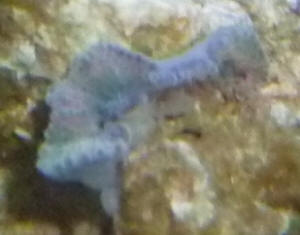 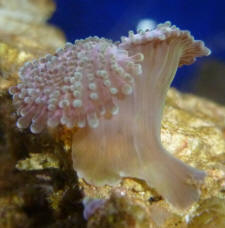
|
|
Green polyps on an Idaho Grape Monti
7/22/11
Hi folks,
<F.M.>
The other day I discovered that the new growth around the edges
of some of the little chips of Tyree LE Idaho Grape Monti that
are around my tank have green polyps instead of purple. It is
only in the new areas, mostly around edges with a polyp or two or
three on the main area - the rest of the polyps are purple like
normal. Nothing has changed in my system. I would like to know
how such a thing could happen. A fellow WAMAS member conjectured
a possible Zooxanthellae protein exchange in my tank with
something else, but I can't find information about this
topic.
<Might be... or some aspect of water chemistry favouring the
production of this sort of pigmentation here... or even another
Polypoid organism.>
I found one post in the old archives of the RC forum where a guy
reported having green polyps on the Tyree LE Idaho Grape Monti,
but responses were to the effect of it not being that type of
coral (since it was an archived post, I couldn't respond to
it). I'm hoping one or more of you folks can give me some
info or direct me to an info source. My camera doesn't have
good enough resolution to get a decent shot of this, but
attaching the best I could get (the piece of coral with the green
polyps on the perimeter is less than 1/2" in diameter).
Coral's background: I bought a frag of this coral a couple
years ago from a fellow WAMAS member, and have since sold/traded
a bunch of frags. A few months ago I decided that the coral,
which was very thoroughly encrusted, was in a really bad place
and was keeping me from growing other corals do to shadowing and
the amount of space it was taking in an area that I wanted for
Acros. I broke as much as I could off the rock to sell &
trade, then scraped off as much as I could of what remained. Due
to heavy encrustation, I could not remove all of the coral and it
grows like a weed. I glued about a couple dozen tiny chips
(1/4" - 1/2") all over a fist-sized piece of rock from
my refugium, and some 1/2" - 1" pieces to a 6"
Acro skeleton - growth pattern of these bits as they encrust into
each other is very cool. The new growth area where the green
polyps are coming out, are on these chips and bits, plus on the
stuff I couldn't scrape off the main rock structure.
System info: 75 gallon mostly hard coral reef tank, system volume
110 gallons (adding sump & refugium, then subtracting
displacement), running about 8 months (with contents from the
tank I broke before I moved... I've been in the hobby roughly
15 years and some of the liverock is from back then). T-5 lights,
long-term Prodibio Biodigest dosing, protein skimmer pulls dark
thick gunk, shallow sand. Nitrate undetectable, phosphate
undetectable, nitrite zero, ammonia zero, specific gravity 1.025,
avg temp 79f, pH 7.9, Alk is in the "normal" color
range of the test kit color card, calcium 420 (I have trouble
with the definition of "blue" in absence of a color
chart comparison, so the 420 figure may be inaccurate). Using
RODI water.
My post on WAMAS about this: http://www.wamas.org/forums/topic/44483-what/
Thanks bunches! Sincerely,
F. Mills
<I might try fragging a central piece... seeing if you can
culture it w/o the green surrounding biomass. Bob Fenner>
|
|
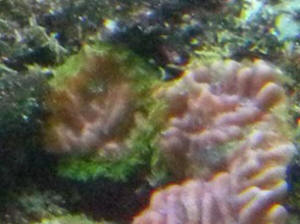
|
|
re: Green polyps on an Idaho Grape
Monti 7/31/11
Thanks for responding again. I finally figured out that I got the
frag from which I grew these green-polyped pieces, from John
Coppolino (the angel fish guy... maybe you know who he is, maybe
not), <I have met the effusive JohnC at a few hobbyist
venues>
in April of 2008. I sent him a PM on WAMAS, but haven't seen
him around for a while, so I'm not sure if he'll answer
any time soon about the parent colony's origin. So I posted
on WAMAS to see if anyone else who got a frag from him knows the
origin of his colony. Hopefully, I'll get some information
soon. I guess if John's colony came from a frag of
Tyree's colony, I'll have to make an inquiry in that
direction. Sincerely, F.
Mills
<Thanks. BobF>
|
Polyp ID 5/17/2011
Dear crew,
<Sam>
First off I would like to ask if the site has been compromised or
something of the sort, because a Google search (I am lazy) of
WetWebMedia told me that "this site may be compromised" and
when I clicked on the link it warned me not to proceed. Are you aware
of any reason for this?
<We are aware of this problem and are currently working on it. We
are sorry for any inconvenience this may have caused you.>
As to my query, I was wondering if you could ID this polyp for me.
<Which polyp?>
At the moment it is only 1/8" inch across, with 8 tentacles and is
a pale white. It looks exactly like an Alcyonium polyp, however because
it is solitary and affixed directly to the rock I am not certain. I
believe it to be a piece of Hawaiian live rock because of the presence
of Sarcothelia Edmondsoni and Hawaiian feather dusters on it, in
addition to the fact that it appears to be of volcanic nature, if that
can help with a possible ID.
I looked into the octocorallia but saw nothing like this as a solitary
polyp. I'm quite certain it is not a Manejo or Aiptasia because it
only has 8 tentacles.
Any ideas?
<Any pictures? Impossible for anyone here to ID based on your
description.>
As always, best regards,
<You're welcome. James (Salty Dog)>
Sam
|
New Coral, ID 4/28/11
Hi WWM crew:
<Howsit Jeff?>
I am hoping you might be able to help me ID the coral in the
attached photos. I had a tough time getting a good picture of
this coral (of course, I can get good photos of all others).
This coral grew from nowhere on the rock it is one. It must be
some sort of an octocoral, but just cannot tell anymore than
that.
Any thoughts are greatly appreciated!!
Cheers Jeff
<Is a small Sarcophyton sp.. Will be getting MUCH larger in
time. Bob Fenner>
|
|
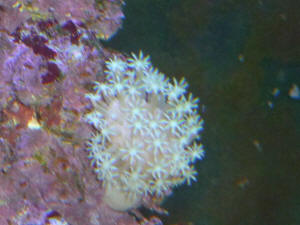
|
Re: New Coral 4/28/11
Thanks Bob! Thought so but the small ones do look different that
the larger ones.
<Mmm, see here: http://wetwebmedia.com/alcyoniidsii.htm
for the genus. BobF> |
|
Help! SW ID, no pic... 4/16/11
I have recently noticed some tiny, almost flowerlike things
growing on my live rock in my 110 gallon tank. I have tried to do
research to figure out what they could be, but came out empty
handed. They are very, very small, and are a
white/transparent-ish color. They are only growing on my
"live" rock rather than on my "real reef"
rock. Help please! Thanks!
Megan
<Likely some type/species of Polypoid Cnidarian life... Read
here:
http://www.wetwebmedia.com/cnidaria.htm
and peruse here: http://www.wetwebmedia.com/CnidIDF26.htm
and the linked files above... Perhaps a Hydroid/Hydrozoan... Do
send along a well-resolved pic if/when you can. Bob
Fenner>
|
|

|
Re: Help! 4/16/11
Thank you, I have attached the nest pictures I could. One just
shows how small they are compared to my tank.
<Mmm, we ask that people limit their file sizes to a few hundred
Kbytes... yours are six and a half plus megs... These are likely
what I stated before, perhaps Zoanthids. Read where you were
previously referred. B> |
|
|

